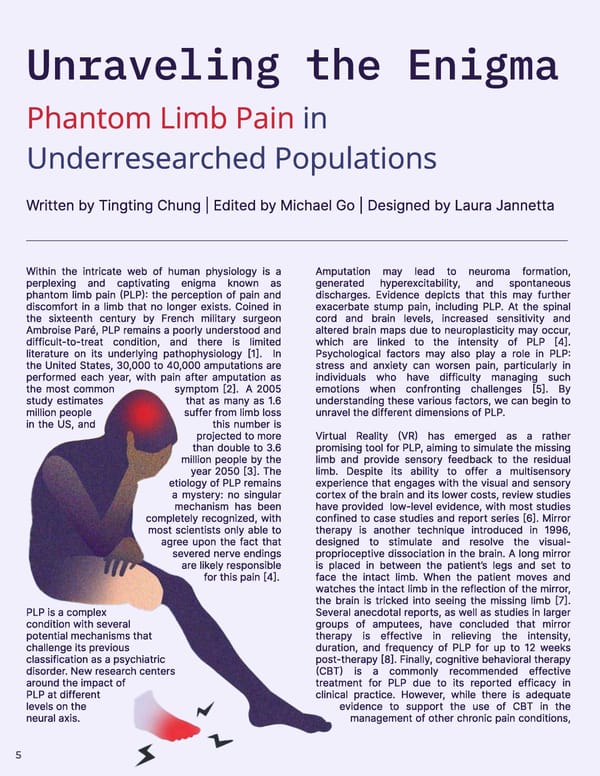Unraveling the Enigma Phantom Limb Pain in Underresearched Populations Written by Tingting Chung | Edited by Michael Go | Designed by Laura Jannetta Within the intricate web of human physiology is a Amputation may lead to neuroma formation, perplexing and captivating enigma known as generated hyperexcitability, and spontaneous phantom limb pain (PLP): the perception of pain and discharges. Evidence depicts that this may further discomfort in a limb that no longer exists. Coined in exacerbate stump pain, including PLP. At the spinal the sixteenth century by French military surgeon cord and brain levels, increased sensitivity and Ambroise Paré, PLP remains a poorly understood and altered brain maps due to neuroplasticity may occur, difficult-to-treat condition, and there is limited which are linked to the intensity of PLP [4]. literature on its underlying pathophysiology [1]. In Psychological factors may also play a role in PLP: the United States, 30,000 to 40,000 amputations are stress and anxiety can worsen pain, particularly in performed each year, with pain after amputation as individuals who have difficulty managing such the most common symptom [2]. A 2005 emotions when confronting challenges [5]. By study estimates that as many as 1.6 understanding these various factors, we can begin to million people suffer from limb loss unravel the different dimensions of PLP.ꨀ in the US, and this number is Virtual Reality (VR) has emerged as a rather projected to more promising tool for PLP, aiming to simulate the missing than double to 3.6 limb and provide sensory feedback to the residual million people by the limb. Despite its ability to offer a multisensory year 2050 [3]. The experience that engages with the visual and sensory etiology of PLP remains cortex of the brain and its lower costs, review studies a mystery: no singular have provided low-level evidence, with most studies mechanism has been confined to case studies and report series [6]. Mirror completely recognized, with therapy is another technique introduced in 1996, most scientists only able to designed to stimulate and resolve the visual- agree upon the fact that proprioceptive dissociation in the brain. A long mirror . severed nerve endings is placed in between the patient’s legs and set to are likely responsible face the intact limb. When the patient moves and for this pain [4].⨀᐀ watches the intact limb in the reflection of the mirror, the brain is tricked into seeing the missing limb [7]. PLP is a complex Several anecdotal reports, as well as studies in larger condition with several groups of amputees, have concluded that mirror potential mechanisms that therapy is effective in relieving the intensity, challenge its previous duration, and frequency of PLP for up to 12 weeks classification as a psychiatric post-therapy [8]. Finally, cognitive behavioral therapy disorder. New research centers (CBT) is a commonly recommended effective around the impact o昀 treatment for PLP due to its reported efficacy in PLP at different clinical practice. However, while there is adequate levels on the evidence to support the use of CBT in the neural axis⸀ management of other chronic pain conditions, 5
 Penn Healthcare Review Fall 2023 Journal— Sports Medicine Page 9 Page 11
Penn Healthcare Review Fall 2023 Journal— Sports Medicine Page 9 Page 11